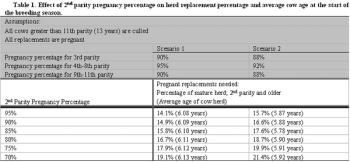Robert Larson, DVM, PhD, DACT, DACVPM
Articles by Robert Larson, DVM, PhD, DACT, DACVPM

Because one goal of proper heifer development is to improve second parity pregnancy percentage, a beef producer may ask "what is the impact of higher pregnancy percentages during the second breeding season on costs and income?" Table 1 displays the effect of changing pregnancy percentage for first-calf heifers in 5-percentage point increments on the percent of the herd that must be replaced each year and the average age of the herd. In general, given the assumptions in the table, for every 5-percentage point improvement in first-calf heifer pregnancy percentage, the number of replacements needed for the herd decreases by about 1 percentage point and average cow age increases by .01 years.

Suckling calves are commonly in contact with the breeding herd during early gestation, prior to the time the bovine fetus develops a competent immune system. As a result, PI suckling calves are considered to be the primary source of BVDV infection in breeding herds causing pregnancy loss, pre-weaning mortality and the induction of PI calves in the next generation.

Productivity for beef cattle herds has been shown to be increased when a high percentage of heifers become pregnant early in the first breeding season. A producer's heifer selection and development program should result in most heifers in the replacement pool reaching puberty at least 42 days prior to the start of breeding because the conception success to first service is lower on the puberal estrus compared to the third estrus.

Many veterinarians express frustration when trying to provide their clients with the best advice on which diagnostic tests to recommend for purchased cattle or the resident herd. The goal is to screen apparently healthy cattle to identify carriers of infectious disease that could cause reproductive losses and other health problems in the herd.

Replacement heifer development is a critically important area for veterinarians to offer production medicine advice to their beef-producing clients. In order for replacement heifers to calve at approximately 24 months of age and to reach puberty the equivalent of three heat cycles before the start of the mature cow breeding season, heifers must become puberal by 11 to 13 months of age.

Trichomoniasis, or "trich," is a disease that can cause devastating reductions in the percentage of cows exposed to a bull that successfully calve. The disease is caused by a protozoan parasite, Tritrichomonas foetus and the organism is transmitted by the act of mating.

Pathogens differ in their virulence, contagiousness, and their modes of transmission. These differences exist not only between pathogens, but for virulence and contagiousness, can also differ between strains of the same species of pathogen.









